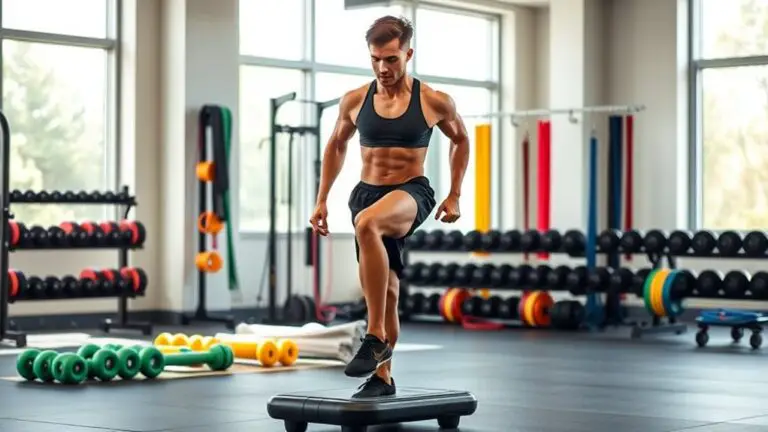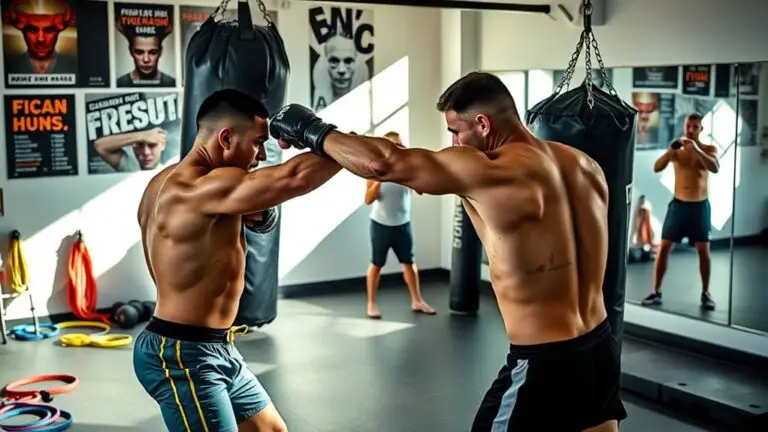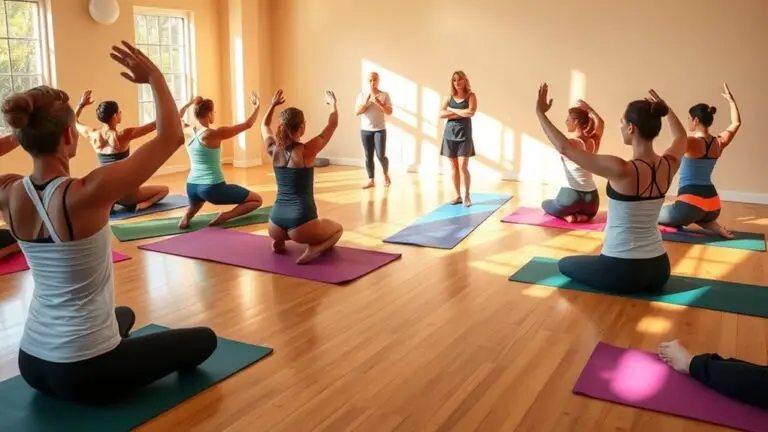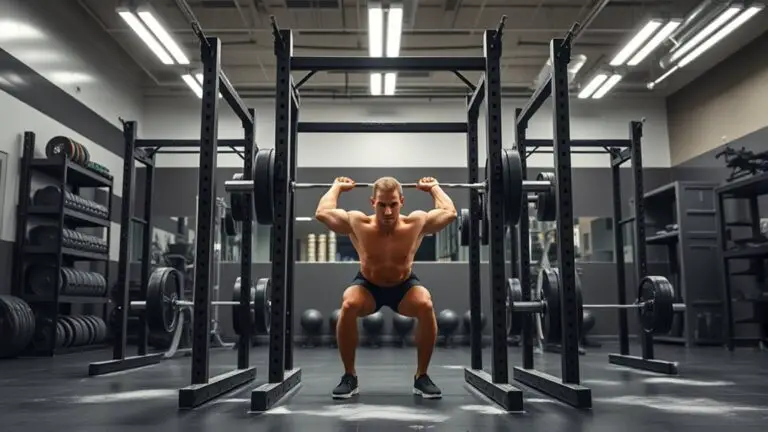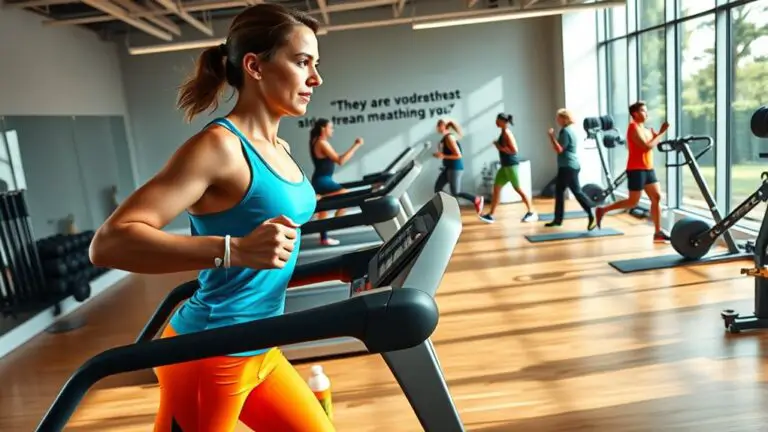How to Choose the Right Yoga Mat for Gym Workouts
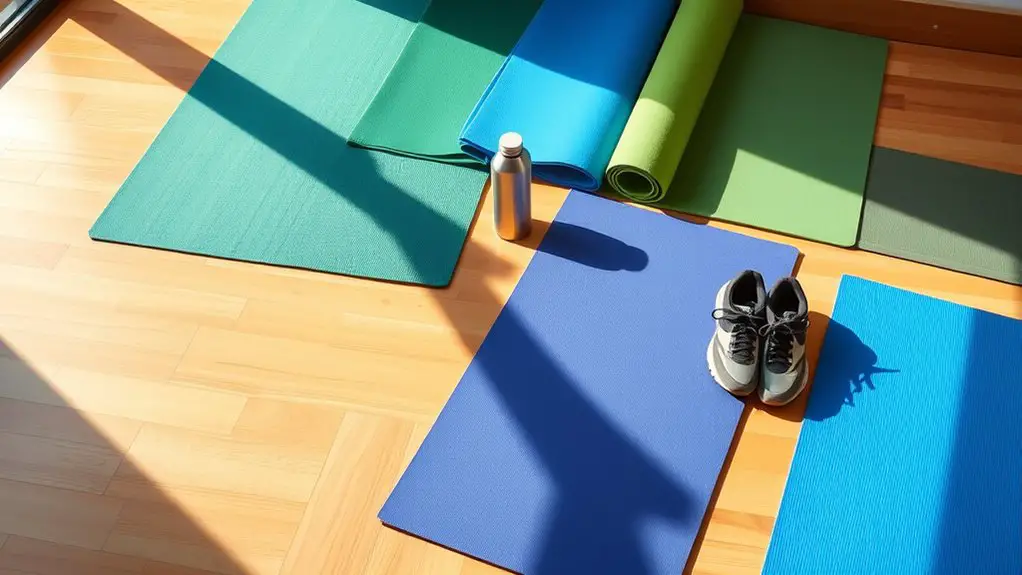
Choosing the right yoga mat for gym workouts starts with understanding your specific needs, like the type of workouts you do and your fitness goals. Look for mats made from durable materials like natural rubber or TPE for good grip. Consider thickness for cushioning and stability, aiming for 4mm to 6mm. Lightweight options with carrying straps make transport easier. Don’t forget to check the size to guarantee it matches your body. Explore further to discover more tips and options!
Understanding Your Workout Needs
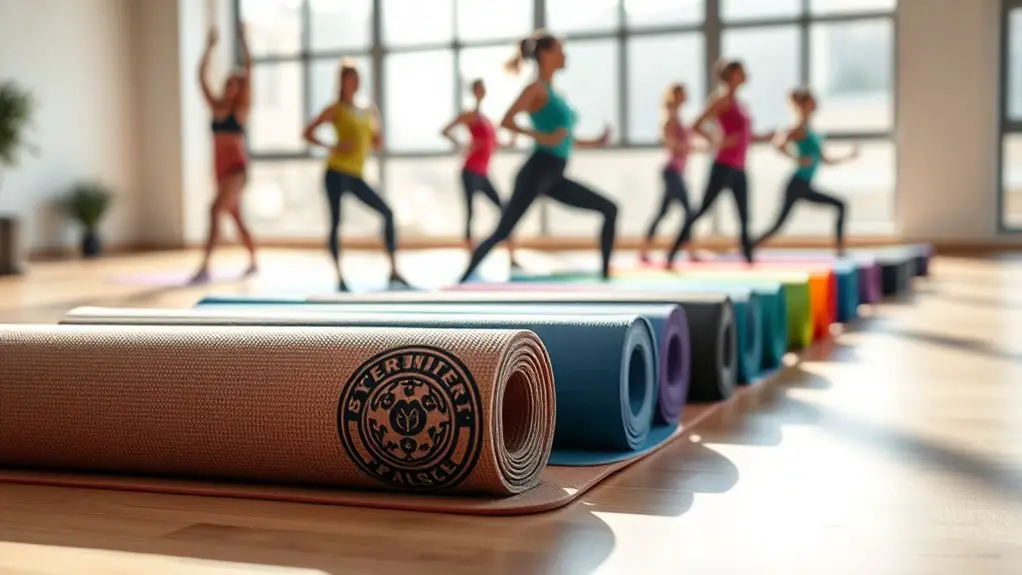
How do you know which yoga mat is right for your workouts? Start by considering your personal fitness goals and workout style preferences. If you’re focused on stability during balance poses, look for a mat with a thicker cushion to support your joints. On the other hand, if you prefer dynamic workouts that require more grip, a mat with a textured surface might be ideal.
Safety is key, so make sure your mat provides ample traction to prevent slips and falls. Think about the type of workouts you’ll be doing—will you be practicing yoga, Pilates, or high-intensity training? Each style demands different features.
Don’t forget about portability if you plan to take your mat to the gym or class. Ultimately, choosing the right mat should align with your fitness journey, helping you feel secure and confident as you work towards your goals.
Exploring Different Mat Materials
When choosing a yoga mat, you’ll want to take into account the materials it’s made from. There are plenty of eco-friendly options that not only benefit the planet but also provide good grip and durability. Understanding these factors can help you find the perfect mat for your gym workouts.
Eco-Friendly Options Available
In recent years, eco-friendly yoga mats have gained popularity, offering sustainable alternatives that benefit both your practice and the planet. When choosing a mat, look for those made from sustainable materials like natural rubber, jute, or hemp. These options not only provide excellent support but also minimize your environmental footprint. Biodegradable options are another great choice, as they break down more easily when disposed of, reducing landfill waste. By opting for eco-friendly mats, you’re ensuring that your workouts are safe for both you and the environment. Plus, many of these mats are free from harmful chemicals, adding another layer of safety to your practice. Make a conscious choice and embrace a greener yoga journey!
Grip and Durability Factors
Choosing the right yoga mat goes beyond just eco-friendliness; grip and durability are critical factors to evaluate. You’ll want a mat that keeps you safe during your workouts, so pay attention to the following aspects:
- Grip Technologies: Look for mats with textured surfaces for enhanced traction.
- Material Composition: PVC, TPE, and natural rubber offer different levels of grip and durability.
- Thickness: Thicker mats can provide better cushioning but may affect stability.
- Durability Tests: Check for mats that withstand wear and tear, ensuring longevity.
- Cleaning Ease: A mat that’s easy to clean will maintain its grip over time.
Evaluating Thickness and Cushioning
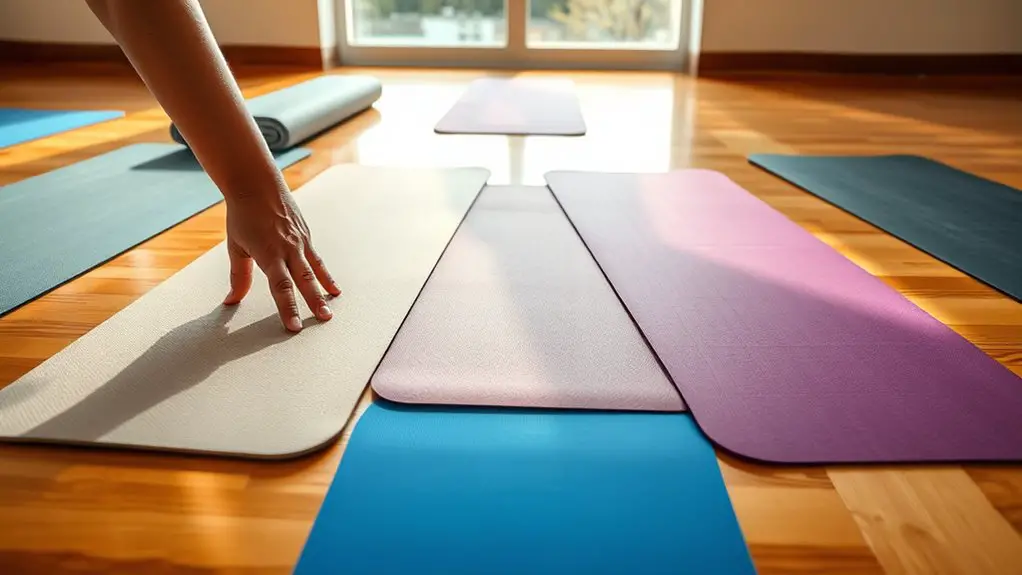
While it may seem tempting to go for the thickest yoga mat available, finding the right balance of thickness and cushioning is essential for your gym workouts. A mat that’s too thick can compromise stability, making it harder to maintain your balance during poses. Ideally, you’ll want a mat thickness that offers enough cushioning to protect your joints without sacrificing support.
Look for mats with cushioning levels that suit your specific needs; if you’re engaging in high-impact workouts or floor exercises, extra cushioning may be beneficial. However, for balance-intensive practices, a thinner mat might be preferable. Aim for a thickness between 4mm to 6mm for a good mix of support and stability. Remember, the right mat can help prevent injuries and enhance your overall experience, so take the time to evaluate your options carefully. Prioritize safety, and choose wisely!
Assessing Grip and Traction
When you’re choosing a yoga mat, grip and traction are essential for your safety and performance. The material composition plays a big role, as different textures and surface patterns can affect how well you stay anchored during workouts. Understanding these factors will help you pick a mat that suits your needs and keeps you stable.
Material Composition Importance
The right material composition of a yoga mat can greatly impact your grip and traction during workouts. Choosing the right material types is crucial not only for safety but also for mat longevity. Here are some key points to take into account:
- PVC: Offers excellent grip but may wear down faster.
- TPE: Eco-friendly alternative with good traction.
- Natural Rubber: Provides superior grip, ideal for sweaty sessions.
- Cotton: Great for stability but less grip.
- Jute: Durable and offers a unique texture.
Investing in a high-quality mat made from suitable materials guarantees safety and enhances your performance. You don’t want to risk slipping during your practice, so prioritize materials that deliver the grip you need.
Texture Types Explained
Selecting the right texture for your yoga mat can make a significant difference in grip and traction during workouts. There are several texture types to take into account, each offering unique texture benefits. For instance, a smooth surface can be comfortable but might not provide enough grip, especially when you sweat. On the other hand, a textured mat enhances traction, helping you maintain stability in poses. Look for mats with raised patterns or grooves, as these can prevent slipping and guarantee your safety. Additionally, reflect on how the mat feels underfoot; a comfortable grip can boost your confidence during challenging movements. Ultimately, choosing the right texture type will enhance your workout experience and reduce the risk of injury.
Surface Patterns Impact
While many factors influence grip and traction on a yoga mat, surface patterns play an essential role in ensuring stability during your workouts. The right design not only enhances safety but also aligns with yoga philosophy, creating a harmonious experience. Consider these aspects when choosing your mat:
- Texture depth: Deeper textures often provide better grip.
- Material type: Some materials naturally enhance traction.
- Pattern design: Unique patterns can improve stability and prevent slipping.
- Surface aesthetics: Choose colors and designs that inspire you.
- Maintenance: Patterns may affect how easily you can clean your mat.
Finding the right balance between functionality and surface aesthetics will keep you grounded and focused during your practice.
Considering Portability and Storage
When you’re on the hunt for a yoga mat suitable for gym workouts, portability and storage should be at the top of your list. You want something easy to carry and store, especially if you’re juggling a busy schedule. Look for mats that roll up compactly and come with straps or carrying bags for added travel convenience.
Consider storage solutions that fit your living space—some mats can even be hung on a wall or stored in a closet without taking up much room. Lightweight options are great for tossing in your gym bag or taking along on trips, ensuring you’re always prepared for a workout.
Finally, check the material; some are more durable and easier to clean than others, contributing to your safety and longevity of use. Prioritize these features, and you’ll find a mat that meets both your fitness and lifestyle needs.
Choosing the Right Size
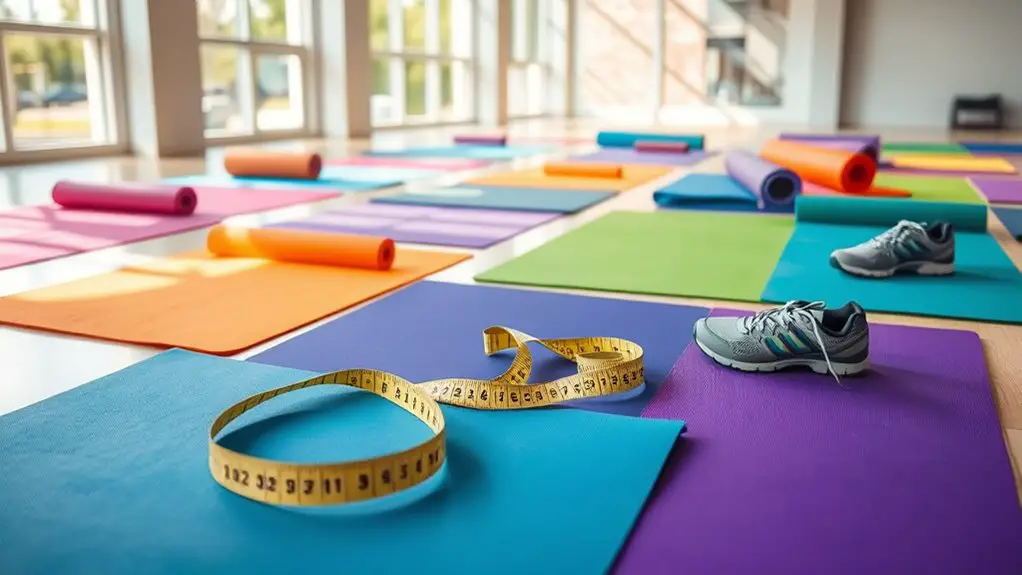
Finding a yoga mat that fits your body size and workout style is just as important as evaluating portability. The right mat dimensions can enhance your practice and guarantee safety during workouts. Here are some factors to assess based on your personal preferences:
- Length: Confirm it’s long enough for your height, providing space for your whole body.
- Width: A wider mat offers more room for side stretches and balancing poses.
- Thickness: Choose a thickness that provides cushioning without compromising stability.
- Material: Some materials may feel better for certain workouts or grip preferences.
- Weight: A lightweight mat is easier to carry, especially if you travel to different gyms.
Selecting the right size not only supports your body but also boosts confidence in your movements. Prioritizing these aspects can lead to a safer and more enjoyable workout experience.
Budgeting for Quality
Investing in a quality yoga mat can make all the difference in your workout experience, and setting a budget is key to finding the right one. You don’t want to compromise safety for price, so think of your mat as a quality investment. Start by determining how much you’re willing to spend without stretching your finances too thin. While you may find budget-friendly options, be cautious—lower prices can sometimes mean lower quality. Look for mats that offer durability, grip, and comfort to guarantee you’re safe during your workouts.
Eco-Friendly Options to Consider
As you seek a yoga mat that aligns with your values, exploring eco-friendly options can enhance both your workout and your commitment to the environment. Choosing mats made from sustainable materials not only guarantees your safety but also reduces your carbon footprint. Here are some eco-friendly options to take into account:
- Natural rubber: Biodegradable and provides excellent grip.
- Cork: Sustainable and antimicrobial, making it a safe choice.
- Jute: A natural fiber that’s strong and eco-friendly.
- TPE (Thermoplastic Elastomer): Made from non-toxic, recyclable materials.
- Organic cotton: Soft and biodegradable, ideal for gentle practices.
Frequently Asked Questions
Can I Use a Yoga Mat for Other Fitness Activities?
Absolutely, you can use a yoga mat for other fitness activities! Its versatility makes it compatible with various workouts, like Pilates, stretching, or bodyweight exercises. Just make certain the mat provides enough grip and cushioning for your specific needs, as safety’s key. If you’re doing high-impact workouts, consider a thicker mat for better support. Ultimately, it’s all about finding the right balance between comfort and functionality for your fitness routine!
How Often Should I Replace My Yoga Mat?
You might not realize it, but your yoga mat’s lifespan is essential for your safety. Over time, wear and tear can lead to slippery surfaces, which can increase injury risk. So, how often should you replace it? Keep an eye out for replacement signs like cracks, peeling, or a loss of grip. Generally, every 6-12 months is a good rule, depending on usage. Don’t compromise your practice; a fresh mat can make all the difference!
Are There Specific Mats for Hot Yoga?
Yes, there are specific mats designed for hot yoga. These mats often use materials like rubber or PVC, providing excellent grip even when you’re sweating. The hot yoga benefits include enhanced flexibility and detoxification, but to stay safe, you need a mat that can handle high temperatures without breaking down. Look for mats labeled as “non-slip” or “high-performance” to guarantee you can focus on your practice without worrying about slipping or discomfort.
How Do I Clean and Maintain My Yoga Mat?
Did you know that a well-maintained yoga mat can last up to five years longer than one that isn’t cared for? To guarantee your mat’s longevity, use gentle cleaning techniques like a mixture of water and mild soap. Wipe it down after each use, and deep clean it weekly. Always let it air dry completely to prevent mold. Keeping your mat clean not only promotes safety but also enhances your practice.
What Brands Are Best Known for Quality Yoga Mats?
When you’re looking for quality yoga mats, Liforme Mats and Manduka Pro are two brands that stand out. Liforme mats provide excellent grip and support, ensuring you stay safe during your practice. Manduka Pro mats are known for their durability and cushioning, making them ideal for various workouts. Both brands focus on safety and comfort, so you can’t go wrong with either choice. Just make sure to pick one that suits your needs!
